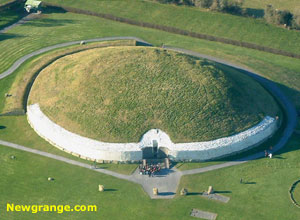Newgrange: Ireland's ancient answer to the pyramids
By Laura Harrison McBride For
the ancient people of Ireland (and continuing until recent times, when Celtic Druidry
was still practiced there by some), the separation between the living and a world beyond
was not nearly as well defined as it is for us moderns. They sought every possible way
to connect with the world beyond the physical world they toiled in, and with their ancestors and an eternal spirit.
For
the ancient people of Ireland (and continuing until recent times, when Celtic Druidry
was still practiced there by some), the separation between the living and a world beyond
was not nearly as well defined as it is for us moderns. They sought every possible way
to connect with the world beyond the physical world they toiled in, and with their ancestors and an eternal spirit.
Ireland is, because of this, littered with Neolithic structures known as passage tombs, but likely incorporating both rituals of death, and rituals of rebirth. (Ireland has always been a land of spiritual seeking, up to and including the High Crosses developed in the early Christian era.)
Newgrange, the largest so-called passage tomb known, is one such magnificent structure, created about 5000 years ago. It exhibits the tomb qualities most often mentioned, but also the ritual and astronomical qualities that were also important to life in the Neolithic universe.
Solstice worship
 The
Neolithic population was mindful that its welfare depended on the seasons and the sun.
And so, although five cremated bodies were found at Newgrange when modern man rediscovered
it, the ancient population also used Newgrange for a spiritual function. On December 21st each year,
the winter solstice,
the deep recesses of the “tomb” are penetrated by a shaft of sunlight,
marking the shortest day of the year, but doubtless also affording a religious experience
for the ancients who labored so hard to build the magnificent structure.
The
Neolithic population was mindful that its welfare depended on the seasons and the sun.
And so, although five cremated bodies were found at Newgrange when modern man rediscovered
it, the ancient population also used Newgrange for a spiritual function. On December 21st each year,
the winter solstice,
the deep recesses of the “tomb” are penetrated by a shaft of sunlight,
marking the shortest day of the year, but doubtless also affording a religious experience
for the ancients who labored so hard to build the magnificent structure.
No one would haul mega-boulders miles over land and water just to make a tomb; “earth magic” was a much more likely explanation for their labors. And hard labor it certainly was. When Newgrange was constructed, the local population lived in meager, wigwam-like huts. And yet, the mound (thought by some to be the ancients' version of a cathedral), was made of both local stone, and stone that came from Wicklow, far to the south by Neolithic standards, or Dundalk Bay, also a great distance. Nor were these stones small enough to hurl; load-bearing stones were the height of a man, and four times a man's girth.
A cosmos in miniature
Newgrange was rediscovered in the late 17th century by people looking for building stone. It wasn't excavated and restored (some of the stone having been removed for new building projects) until between 1962 and 1975. Some parts of the Newgrange campus have never been restored, however. For instance, at one time there were 35 standing stones around the main Newgrange structure, some now long gone. Celtic spirituality researchers believe that, at one time, the mound and stone circles represented the cosmos, as it was then known via the night skies. They also believe rituals were carried out there for hundreds of years.Win a lottery for earth magic
Today, the single ritual carried out and not in a religious sense, but more an historical one is the observation of the sun's entry to the mound on December 21st. Because the mound has suffered in recent decades from too much visitation, visits are now via strictly controlled tours, and the events on the mornings around December 21st can be attended only by entering and winning a lottery managed at the Newgrange Visitor Center. Only 100 lucky names are drawn and then those 100 have to get lucky in the weather. If there is no sun, there is no event. But still, even waiting for it would be a way to reconnect with the ancient people and ritual of Ireland.A place to gain wealth
Newgrange, supposed to have been sacred to Dagda in the ancient lore of the Tuatha De Danaan (the first inhabitants of Ireland, pre-Celtic). Dagda was always pictured with a cauldron of gold. In the current economy, it wouldn't hurt at all to go have a look at such a place. Who knows? Maybe the luck of the Irish, and some of those pre-Celtic riches, will rub off.Boyne Valley Private Day Tour
 Immerse yourself in the rich heritage and culture of the Boyne Valley with our full-day private tours.
Visit Newgrange World Heritage site, explore the Hill of Slane, where Saint Patrick famously lit the Paschal fire.
Discover the Hill of Tara, the ancient seat of power for the High Kings of Ireland.
Book Now
Immerse yourself in the rich heritage and culture of the Boyne Valley with our full-day private tours.
Visit Newgrange World Heritage site, explore the Hill of Slane, where Saint Patrick famously lit the Paschal fire.
Discover the Hill of Tara, the ancient seat of power for the High Kings of Ireland.
Book Now

Home
| Visitor Centre
| Tours
| Winter Solstice
| Solstice Lottery
| Images
| Local Area
| News
| Knowth
| Dowth
| Articles
| Art
| Books
| Directions
| Accommodation
| Contact
